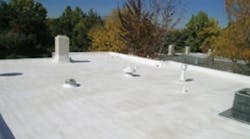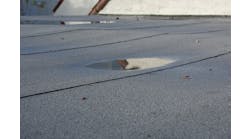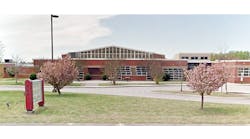Roofs always have been a major focus for building energy-conservation measures. The emphasis traditionally has been on beefing up insulation. More recently, advances in roofing materials technology and analytical techniques have found new ways to fine-tune the energy performance of roofing to reduce not only operating costs, but also environmental impact. The so-called "cool roof" is one of these.
Consequently, cool roof products are in vogue among architects, facility managers and building owners. Popular green building programs, such as the U.S. Green Building Council’s LEED and the Green Building Initiative’s GreenGlobes, offer credits for use of cool roof materials. A growing number of national building codes (e.g., ASHRAE Standard 90.1, California’s Title 24 Building Energy Efficiency Standards), as well as a number of local codes, including those in Chicago, Houston and Dallas, include cool roof requirements.
Keep it cool
A cool roof minimizes the solar heat gain of a building by reflecting the bulk of incoming radiation and then quickly re-emitting the remaining absorbed portion. The cool roof stays cooler than traditional construction, minimizing the transfer of heat to the building below.
Although cool roofs typically are white or other light colors, darker colors can be engineered for cool roof performance. They can be found in a variety of materials (shingles, slate or tile, single-ply or built-up, metal) and can be applied to virtually any building or roof slope in any location. They promise reduced energy costs and longer AC unit life because of reduced air-conditioning load, and increased roof longevity because of reduced thermal flux. In addition, they can improve air quality by reducing ambient air temperatures, thus mitigating the urban heat-island effect.
Cool ratings
To accurately determine a roofing product’s "coolness," the two radiative properties of solar reflectance and thermal emittance must be measured.
Technically, solar reflectance isthe fraction of solar energy reflected by a roofing material’s surface, expressed on a scale from 0 to 1.0. A solar reflectance of 1.0 (100 percent reflected) would mean no effect on surface temperature, and a reflectance of 0 (none reflected, all absorbed) would result in the maximum heating effect. Solar reflectance is determined in the laboratory (and sometimes in the field) in accordance with ASTM test methods C 1549, E 1918 and/or E 903, depending on the roofing material’s color and texture.
Thermal emittance also is expressed on a scale from 0 to 1.0, so a roofing material with a higher thermal emittance (closer to 1.0) will re-emit absorbed thermal energy more quickly than a material with a low emittance, resulting in a "cooler" roof. Thermal emittance is measured per the laboratory test procedure ASTM C 1371.
A force in the promulgation of cool roof technology is the Cool Roof Rating Council (CRRC), which has created an accreditation and reporting system for testing and listing the solar reflectance and thermal emittance of any roofing product. A manufacturer chooses a CRRC-Accredited Independent Testing Lab (AITL), which conducts testing according to designated ASTM and CRRC test methods.
The CRRC program does not specify minimum requirements for solar reflectance or thermal emittance and does not set a threshold definition for "cool," leaving that to code bodies and programs that reference CRRC ratings (such as the Department of Energy’s (DOE) ENERGY STAR Roofing Products program).
ENERGY STAR, however, specifies only a minimum solar reflectance and says nothing about emittance, requiring an initial solar reflectance of at least 0.65, and weathered reflectance of at least 0.50 for low-slope roof applications. For steep-sloped installations, initial reflectance must be at least 0.25 with an aged value of 0.15. (A low-slope roof is defined as that with a pitch less than or equal to 2:12; a steep-sloped roof has a pitch greater than 2:12. For aged ratings, product samples are exposed for three years at a CRRC-approved outdoor "test farm."
The Green Building Initiative’s (GBI) GreenGlobes system does take thermal emittance into account and awards points for roofing materials with a solar reflectance of at least 0.65 and an emittance of at least 0.90.
However, note that a high reflectance value or a high emittance value alone will not automatically result in a "cool" roof.
The U.S. Green Building Council’s Leadership in Energy and Environmental Design (LEED) program, arguably the nation’s most influential green building program, attempts to take this into account by not specifying separate values for solar reflectance and thermal emissivity. Instead, LEED—as well as a number of local building codes—defers to another quantity, the Solar Reflective Index (SRI), which combines these values into a single index. SRI is derived by a calculation method set forth in ASTM E 1980, which yields a number from 0 to 100. The standard black roof is given an SRI value of 0; a standard white roof is assigned an SRI value of 100.
Although not required for LEED certification, reflective cool roofs exhibiting an SRI of 78 or greater for low-sloped roofs, or at least 29 for steep-sloped roofs, and covering at least 75 percent of the roof surface, earn an additional Sustainable Sites Credit 7.2 point toward a project’s overall LEED score.
Too cool?
Cool roofing is not without controversy. Some studies have shown that reflective roofs are not always best in cool climates, where low emissivity could benefit heating systems in cold weather. Potentially damaging condensation within a roofing assembly also can be aggravated in such climates because of the enhanced temperature differential between the warm interior and the cooler roof.
This can be of particular interest for designers and facility managers of education institutions, which often are closed during the summer months and thus experience minimal air-conditioning demand for cool roofing to leverage against. The DOE’s Buildings Energy Data Book, for example, has noted that on average, education facilities use 33 percent of their total annual energy consumption on heating, but only 5 percent on cooling.
To help estimate cooling and heating savings through use of cool roofing, the DOE’s Oak Ridge National Laboratory (ORNL) has developed a cool roof calculator. A similar calculator offered by the EPA for ENERGY STAR evaluations enables a designer to input specific details about a building, including heating and cooling systems, as well as location and the cost of energy. These calculators provide a simple payback analysis to determine the savings in electricity or natural gas through the installation of a cool roof.
According to a paper issued by a single-ply roofing manufacturer, studies using this DOE calculator were instrumental in persuading the School Building Authority (SBA) of West Virginia to reverse an earlier blanket decision to require highly reflective roofing on all buildings in the state. Other investigations using the EPA calculator have shown that high-reflectivity, medium-emissivity roof coatings such as aluminum can yield greater savings in colder regions.
Many designers believe that only white roofs meet the criteria for cool roofs, that flat or low-sloped roofs are the only ones that benefit from the specification of a cool roofing material, and that a cool roof is beneficial only in hot climates. However, roofing materials now are available with spectrally selective pigments that reflect infrared energy, even though their color still may absorb some of the visible light spectrum. In this way, roofing products can be both "cool" and dark-colored. This provides more opportunities for designers to incorporate aesthetic considerations.
Total performance
Although green properties and energy savings often receive the lion’s share of attention, design considerations should go beyond energy efficiency and green attributes to encompass long-term performance of the building envelope. Instances are beginning to surface in which LEED-certified and other green-rated buildings have developed performance problems, such as water leakage, which is not addressed by LEED criteria. Other examples include testing for the ability of the roofing system to resist uplift forces because of high winds and damage from hail impact.
As always, full consideration of all performance challenges posed by a building’s location and use should be evaluated and addressed with optimized design solutions. Concentration on just one aspect or feature, especially as a means to earn rating credits, can result in over-building or under-building for the need at hand—both of which result in higher costs without improved performance.
Westerling, PE, is project engineer-solar department, with Architectural Testing Inc., york, Pa., a product testing service with ISO/IEC 17025-accredited capability to perform more than 2,000 defined test protocols at one or more of its nine laboratory locations. [email protected].



